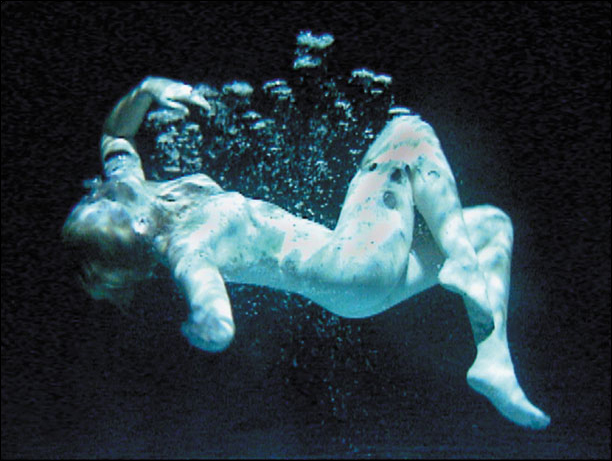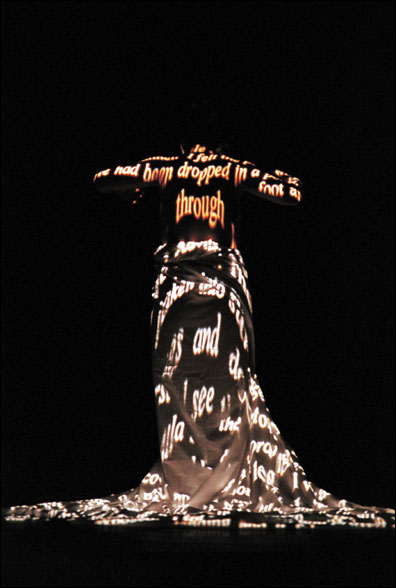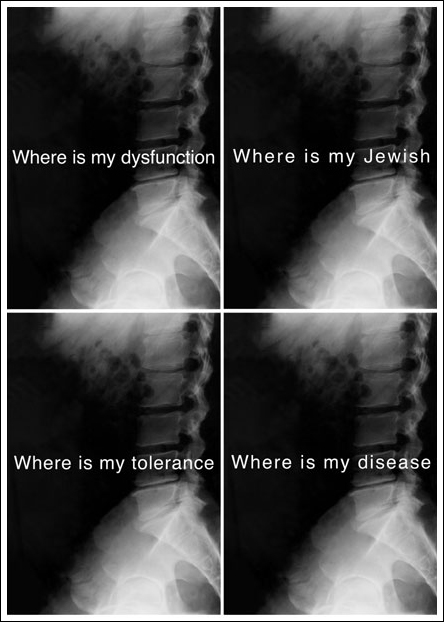Douglas Rosenberg’s Gesamptkunstwerk
Douglas Rosenberg makes artwork through a combination of such forms and elements as dance, cinematography, sculpture, landscape, imaging technology and sound. Working with the body, diverse media and juxtaposed elements, Rosenberg invites us to partake in narrative works that challenge traditional boundaries between art and life. His interdisciplinary approach to art making brings to mind a historical current in the arts that was popularized by the 19th century composer Richard Wagner.

Gesamptkunstwerk
In 1849, Richard Wagner published his aesthetic treatise The Art Work of the Future. In it he railed against the notion of specialization in the arts and maintaining that art attains its highest expression in a collective unity he referred to as the gesamptkunstwerk or “total art work.” For Wagner, this collectivization of the arts found its most perfect expression in the musical form of opera. I see the gesamptkunstwerk idea in Douglas Rosenberg’s work through its painterly use of the medium of video, sculptural elements, theatrical sets, real landscapes, dance and music. The artist combines disparate elements with great sensitivity, coaxing them to work together to an expressive end. The resultant works are both hauntingly beautiful and disconcerting, examining aspects of life, human nature, cultural and personal identity and social taboos that raise challenging issues about our existence.

Dziga Vertov Performance Group
In 1991 Rosenberg founded the Dziga Vertov Performance group in order to develop new works that combine dance, performance and media with such elements as text projections, all filtered through Rosenberg’s masterful use of the camera. Dziga Vertov was an early Soviet filmmaker who believed in the primacy of the camera or “Kino Eye,” relying on it to make sense of the myriad images that otherwise bombard our senses. Like Vertov, Rosenberg possesses an ability to distill essential movements and gestures, creating montage works that resonate with our emotions.
A case in point would be Rosenberg’s Falling / Falling a 1998 video installation. This work depicts a nude woman, falling deeper and deeper into a body of water. She moves in response to the currents that surround her and carry her downward while her mouth tries to form words but is silenced by the aqueous void. Her hair suffers a sea change, floating about her like the silken pennant billowing in the wind. Partially inspired by the passing of the artist’s father, the piece addresses the theme of death. This is embodied both in the person of a drowning woman and the personification of death which is traditionally feminine. At the same time this image is both sensual and erotic, as this beautiful, graceful woman moves through the water, exploring the notion of the death of reason and analogies between death and sexuality.

Venous Flow, States of Grace a 2003 collaboration between Rosenberg and dancer / choreographer Li Chiao-Ping, grew out of a serious car accident that both artists suffered and which threatened Chiao-Ping’s future as a dancer. The title refers to an examination she underwent in the hospital, testing the flow of blood from her heart to her foot. Rosenberg opened the work with three dancers standing in an austere dark space, illuminated words projected onto their bare backs. This text moves across their bodies, revealing fleeting allusions to the accident. Then an elderly woman recites the story of Humpty Dumpty, a fairy tale which, in the guise of Pinocchio, becomes a leitmotiv in Douglas Rosenberg’s work. Over the course of Venous Flow, dancers from different ages and walks of life speak to the experience of loss and healing. These reflections are reinforced by movements from Chiao-Ping’s choreography which are quintessentially expressed by Rosenberg’s camera work and editing sensibility. The nature of giving and receiving grace during hardship is explored at one point in the relationship between an old man and a young woman. They take turns balancing one another on their backs and then the old man, as in a second childhood, seeks solace in playing a miniature toy piano. As he begins to play the young woman tantalizes him, pulling it just beyond his reach, and he pursues it. The last scene Rosenberg films on the ice of a frozen lake in Wisconsin. Each of the protagonists from the work assembles on this barren expanse of ice, girded by trees in the distance. Once again Rosenberg and Chiao-Ping work in perfect sync, capturing the affirmation of grace and healing through eloquent movements above the lurking danger of cold-water lying fathoms beneath the dancer’s feet.
The Pinocchio Stories
In his recent essay The Pinocchio Stories, Rosenberg recounts the story of a sadistic, racist and abusive patriarch named Geppetto who decides to craft a wooden protegé to molest and indoctrinate with his troubled ideology. PIPIPIPINNOCHIO is crafted from scraps of pine and, Frankenstein-like, imbued with life by his creator. Geppetto sodomizes the little doll each night and fills it with hateful ideas, fashioning, “a tiny wooden klansman, a hand-carved racist, a Pinocchio Hitler, a Muslim hating, Jew baiting knot head.” With each lie Pinocchio’s nose, a surrogate phallus, begins to grow, and the puppet begins to associate pleasure with transgression. Together with his father this wooden boy piques the interest of news media a begins to make regular appearances on such programs as Geraldo, Inside Edition, Jerry Springer, Hard Copy and other programs, “goose-stepping to the beat of a different drummer.” Rosenberg speculates as to the way this story might end and the possibilities leave little room for optimism. Pinocchio might murder Geppetto with a shotgun as he sleeps or, Geppetto, jealous of the attention lavished upon his progeny, might douse Pinocchio with gasoline and set him aflame. In a final gesture of self-hatred Geppetto would wrap his mouth around the barrel of a shotgun and fire both barrels.

Cinematographs
The Pinocchio story reemerges in Rosenberg’s Cinematographs, a series of inkjet prints which explore the nature of identity through mask wearing, medical imaging and fingerprints. With dark humor and occasional irony these works call to mind Romanian playwright Eugéne Ionesco’s Rhinoceros in which common people are transformed into brutal animals in what is commonly regarded as a metaphor for Fascism. Rosenberg is interested in the complicity of common people with forms of totalitarianism and how this complicity is elicited through a cycle of abuse. Untitled #6 (cinematograph), is a digital print which juxtaposes an X-Ray image of vertebrae, Douglas Rosenberg in profile wearing a Pinocchio nose, a fingerprint and veiled superimpositions of the artist’s face head on. The nose is made of sharp rolled tin and seems to pierce a membrane to the fingerprint. Untitled #3 (Cinematograph) depicts a blindfolded Rosenberg with an expression of seeming rapture, tightening a noose around his own neck. To the left of this image (which is perfectly illuminated in the tradition of film noir) are two profile X-Rays of a skull, positioned en face. A particularly disconcerting image is Untitled #1 (Cinematograph), a montage of X-Rayed teeth, a superimpositon of the Pinocchio nose over a photograph of the artist and a fingerprint. The most recent works in this series combine medical imaging with text questions such as “Where is my dysfunction?” or “Where is my Jewish?” examining the psychological, spiritual and metaphysical aspects of existence by their very absence in the image.

Jewish Influences
Rosenberg was raised in a practicing Jewish family in San Francisco during the 1960s. Eight generations of his family had been Rabbis in Europe and the artist took an early interest in Jewish culture. During the multicultural 1980s when otherness became fashionable, Rosenberg began to question what defines Jewish art and what are the constant threads in modern and contemporary art made by Jewish practitioners. In 1982 he was invited to perform in Germany during Dokumenta 7 in Kassel. During this visit he witnessed the massive burnt offering paintings of Anselm Kiefer and met numerous German artists including Joseph Beuys. Rosenberg’s ideas about the Holocaust and its origins began to mature. Much of the artist’s performance work and installation work addresses the issue of domination and the dangers of any sort of complicity with or submission to Fascism. More recently Rosenberg has become interested in the way in which Jewish liturgy hinges on text. Hebrew calligraphy of the Torah is considered too sacred to touch and is followed by the cantor with a Yad or pointer. Therefore, his use of white illuminated text projections in “Venous Flow, States of Grace” takes on a special meaning. In the Luriac Cabbala there is a concept of white and black fire that describes the black Hebrew calligraphy against the light parchment of a Torah scroll. The Cabbala also speaks to the need for tikkun olam or healing the world. Perhaps this begins with healing oneself as in Venous Flow, States of Grace both physically and spiritually, and extends to guarding oneself and the world from decline into negative states of being.
© 2005 Daniel Rothbart. All rights reserved.